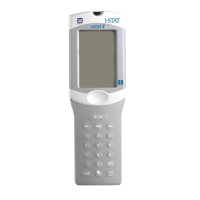PROCEDURE MANUAL FOR THE i-STAT SYSTEM
1
REV. DATE: 16-Oct-12 ART: 714446-00L
SYSTEM OVERVIEW
The i-STAT System incorporates comprehensive components needed to perform blood analysis at the point of care. The
System consists of the following primary components:
Analyzers
Analyzers (handhelds) can be the i-STAT Portable Clinical Analyzer or the i-STAT 1 Analyzer. When a sample-filled
i-STAT cartridge is inserted into a handheld for analysis, the handheld automatically controls all functions of the testing
cycle including fluid movement within the cartridge, calibration and continuous quality monitoring.
Analysis Time
ACT cartridge: to detection of end point - up to 1000 seconds (16.7 min.)
PT/INR cartridge: to detection of end point – up to 300 seconds (5 min.)
cTnI and BNP cartridges: 600 seconds (10 min.)
CK-MB Cartridge: 300 seconds (5 min.)
Other cartridges: typically 130 to 200 seconds
Cartridges
A single-use disposable cartridge contains microfabricated sensors, a calibrant solution, fluidics system, and a waste
chamber. Sensors for analysis of pH, PCO
2
, PO
2
, TCO
2
, sodium, potassium, chloride, ionized calcium, glucose, lactate,
creatinine, urea nitrogen (BUN) and hematocrit are available in a variety of panel configurations. Cartridges are also
available for Celite-ACT, Kaolin-ACT, PT/INR, Troponin I/cTnI, CK-MB and BNP (Table 1). A whole blood sample of
approximately 1 to 3 drops is dispensed into the cartridge sample well, and the sample well is sealed before inserting it into
the analyzer.
Central Data Station or Data Manager
A dedicated desktop computer with the i-STAT Central Data application provides the primary information management
capabilities for the i-STAT System. IR Links for Portable Clinical Analyzers and Downloaders and Downloader/Rechargers
for the i-STAT 1 Analyzers allow for transmission of patient records from a widely distributed network of handhelds to the
Central Data Station application. Data can be stored, organized, edited, and transferred to a laboratory information system or
other computer system. Cartridge usage and efficiency reports can be generated for management of the System.
SUPPLIES and STORAGE REQUIREMENTS
Cartridges
Cartridges are sealed in individual pouches or portion packs. Store the main supply of cartridges at a temperature between 2
to 8°C (35 to 46°F). Do not allow cartridges to freeze. Cartridges may be stored at room temperature (18 to 30°C or 64 to
86°F) for the time frame indicated on the cartridge box. Cartridges should not be returned to the refrigerator once they have
been at room temperature, and should not be exposed to temperatures above 30°C (86°F). If the pouch has been punctured,
the cartridge should not be used. Write the date on the cartridge box or individual cartridge pouches to indicate the room
temperature expiration date. Cartridges should remain in pouches until time of use. Do not use after the labeled expiration
date.

